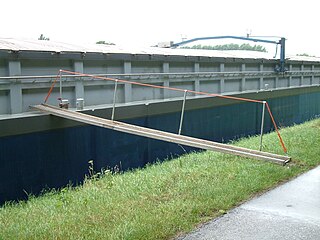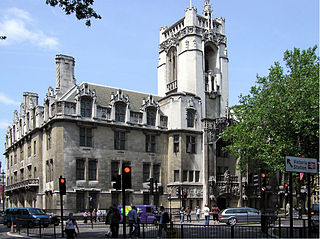A tort, in common law jurisdictions, is a civil wrong that causes a claimant to suffer loss or harm resulting in legal liability for the person who commits the tortious act.
An affirmative defense to a civil lawsuit or criminal charge is a fact or set of facts other than those alleged by the plaintiff or prosecutor which, if proven by the defendant, defeats or mitigates the legal consequences of the defendant's otherwise unlawful conduct. In civil lawsuits, affirmative defenses include the statute of limitations, the statute of frauds, waiver, and other affirmative defenses such as, in the United States, those listed in Rule 8 (c) of the Federal Rules of Civil Procedure. In criminal prosecutions, examples of affirmative defenses are self defense, insanity, and the statute of limitations.
In civil proceedings and criminal prosecutions under the common law, a defendant may raise a defense in an attempt to avoid criminal or civil liability. Besides contesting the accuracy of any allegation made against them in a criminal or civil proceeding, a defendant may also make allegations against the prosecutor or plaintiff or raise a defense, arguing that, even if the allegations against the defendant are true, the defendant is nevertheless not liable.
Fruit of the poisonous tree is a legal metaphor in the United States used to describe evidence that is obtained illegally. The logic of the terminology is that if the source of the evidence or evidence itself is tainted, then anything gained from it is tainted as well.

English tort law concerns the compensation for harm to people's rights to health and safety, a clean environment, property, their economic interests, or their reputations. A "tort" is a wrong in civil, rather than criminal law, that usually requires a payment of money to make up for damage that is caused. Alongside contracts and unjust enrichment, tort law is usually seen as forming one of the three main pillars of the law of obligations.
The last clear chance is a doctrine in the law of torts that is employed in contributory negligence jurisdictions. Under this doctrine, a negligent plaintiff can nonetheless recover if he is able to show that the defendant had the last opportunity to avoid the accident. Though the stated rationale has differed depending on the court adopting the doctrine, the underlying idea is to mitigate the harshness of the contributory negligence rule. The defendant can also use this doctrine as a defense. If the plaintiff has the last clear chance to avoid the accident, the defendant will not be liable.
Volenti non fit iniuria is a common law doctrine which states that if someone willingly places themselves in a position where harm might result, knowing that some degree of harm might result, they are not able to bring a claim against the other party in tort or delict. Volenti applies only to the risk which a reasonable person would consider them as having assumed by their actions; thus a boxer consents to being hit, and to the injuries that might be expected from being hit, but does not consent to his opponent striking him with an iron bar, or punching him outside the usual terms of boxing. Volenti is also known as a "voluntary assumption of risk."
Comparative responsibility is a doctrine of tort law that compares the fault of each party in a lawsuit for a single injury. Comparative responsibility may apply to intentional torts as well as negligence and encompasses the doctrine of comparative negligence.

Central Trust Co v Rafuse, [1986] 2 SCR 147 is a leading decision of the Supreme Court of Canada on liability of solicitors in negligence and breach of contract as well as the doctrine of discoverability under the Statute of Limitations.
In the English law of negligence, the acts of the claimant may give the defendant a defence to liability, whether in whole or part, if those acts unreasonably add to the loss.
The following outline is provided as an overview of and introduction to tort law:
Illegal defense or illegality defence may refer to:

Hewison v Meridian Shipping Services Pte[2002] EWCA 1821 is an English tort law case, concerning an employer's liability for an employee's illegal acts.

Stone & Rolls Ltd v Moore Stephens[2009] UKHL 39 is a leading case relevant for UK company law and the law on fraud and ex turpi causa non oritur actio. The House of Lords decided by a majority of three to two that where the director and sole shareholder of a closely held private company deceived the auditors with fraud carried out on all creditors, subsequently the creditors of the insolvent company would be barred from suing the auditors for negligence from the shoes of the company. The Lords reasoned that where the company was only identifiable with one person, the fraud of that person would be attributable to the company, and the "company" could not rely on its own illegal fraud when bringing a claim for negligence against any auditors. It was the last case to be argued before the House of Lords.
Illegality in English law is a potential ground in English contract law, tort, trusts or UK company law for a court to refuse to enforce an obligation. The illegality of a transaction, either because of public policy under the common law, or because of legislation, potentially means no action directly concerning the deal will be heard by the courts. The doctrine is reminiscent of the Latin phrase "Ex turpi causa non oritur actio", meaning "no cause of action arises from a wrong". The primary problem arising when courts refuse to enforce an agreement is the extent to which an innocent party may recover any property already conveyed through the transaction. Hence, illegality raises important questions for English unjust enrichment law.
Common employment was an historical defence in English tort law that said workers implicitly undertook the risks of being injured by their co-workers, with whom they were in "common employment". The US labor law terminology was the "fellow servant rule".

Jetivia SA v Bilta (UK) Limited [2015] UKSC 23 is a UK company and insolvency law decision of the Supreme Court of the United Kingdom in relation to (i) the attribution of unlawful acts of a director to the company where the company is the victim of the unlawful act, and (ii) the extent to which liability for fraudulent trading under section 213 of the Insolvency Act 1986 has extraterritorial effect.

Patel v Mirza[2016] UKSC 42 is an English contract law case concerning the scope of the illegality principle relating to insider trading under section 52 of the Criminal Justice Act 1993.






